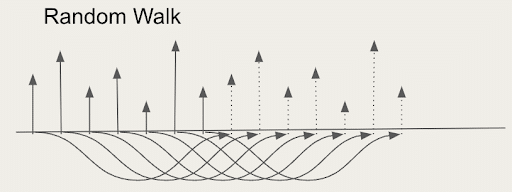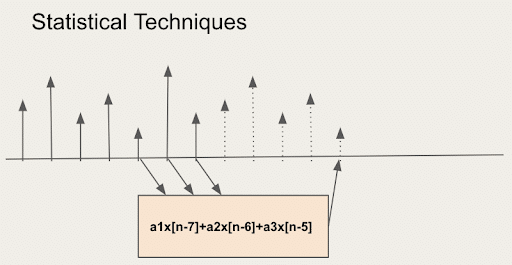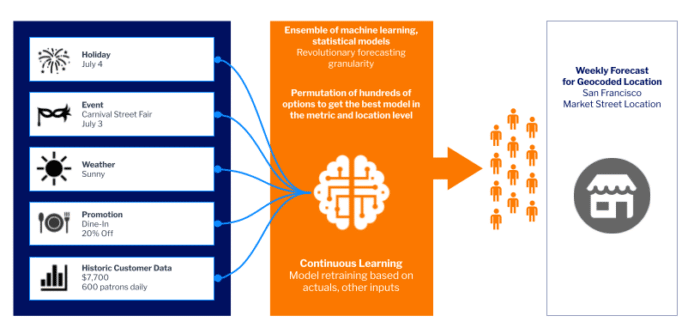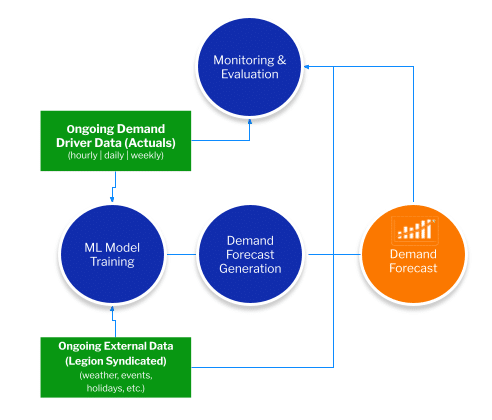Driving Accuracy and Precision with Intelligently Automated Demand Forecasting
March 6, 2024
by Farshad Kheiri, PhD

Legion Workforce Management empowers organizations to enhance labor efficiency and boost employee engagement through its advanced workforce management software that combines intelligent automation with a focus on employee-centric operations.
Our solution ensures optimal labor utilization for improved organizational performance by accurately determining the necessary labor to meet demand. Legion Demand Forecasting provides fully automated demand forecasts based on mature data science—in production for 7+ years—to deliver precise, accurate forecasts. This blog will explore why this approach is better suited for retailers.
Why Use Artificial Intelligence (AI) for Forecasting?
Traditionally, retail store managers relied on the previous week's demand to forecast future needs, employing a method known as "random walk." While this term is common in probability and statistics, how it is used in this case is different. “Random Walk” in this approach allows for estimating forthcoming demands based on recent trends and is distinct from the mathematical theory of random processes.

Sophisticated retail managers often enhance forecasting accuracy by implementing statistical methods like moving averages. For instance, they might predict the following Monday's foot traffic by averaging the data from the previous six Mondays.
Further elevating their predictive capabilities, some managers adopt more intricate methodologies, including ARIMA (Autoregressive Integrated Moving Average) and SARIMA (Seasonal ARIMA). These advanced techniques leverage linear combinations of historical data to provide more precise future forecasts.

Why is AI Better in Forecasting?
The superiority of Artificial Intelligence (AI), through machine learning (ML) methodologies, in contemporary problem-solving and automation is increasingly evident. In demand forecasting, ML offers unparalleled advantages, enabling managers to:
- Identify and analyze complex patterns across extended timeframes, surpassing traditional methods in depth and accuracy.
- Integrate and process diverse data inputs from multiple sources, providing a holistic view of demand influencers.
- Dynamically update forecasts in response to real-time data changes, ensuring predictions remain relevant and accurate.
The application of ML techniques in demand forecasting significantly enhances accuracy and reliability, not only optimizing operational efficiency but also supporting strategic decision-making by offering comprehensive and adaptive insights into market dynamics.
What Data is Needed?
The Legion AI platform is designed to harness a wide array of data points for optimal forecasting. However, the primary requirement from our clients is the provision of key demand drivers they aim to predict, including metrics like traffic, sales, and transaction volumes. Clients are encouraged to submit this critical data with the desired level of detail, whether in 15-minute increments at hourly, daily, weekly, or monthly intervals.
To augment the precision of our forecasts, we also invite clients to provide historical data related to the specific demand drivers in question. Additionally, clients can enhance forecast accuracy by supplying information on anticipated special events that may influence demand, such as promotional campaigns or sales events. By integrating these variables into our AI-driven engine, Legion significantly improves the reliability and relevance of its demand forecasting outcomes.
How Forecasts are Generated and Why Accuracy is Higher
Forecasts are generated through a sophisticated process that incorporates many external factors, including economic conditions, weather variations, and proximate events, among others.
Machine learning techniques are adept at assimilating these diverse data points alongside current demand indicators to produce forecasts of superior accuracy. This enhanced precision is attributable to ML's ability to comprehensively analyze external events and their influence on historical data patterns.
Legion's Workforce Management (WFM) platform leverages an extensive suite of hundreds of machine learning and statistical models, meticulously selecting the most suitable ensemble model for forecasting. This selection process is based on the model's ability to integrate and analyze vast datasets to identify the most relevant patterns and influences.
As a result, the forecasts generated by Legion WFM are highly accurate and tailored to each customer's unique demand dynamics, ensuring optimal resource allocation and strategic planning.

When a new location is inaugurated, or additional data begins to be collected at an existing site, the challenge of lacking historical data arises. To address these challenges, various methods for generating synthetic data have been explored, each offering distinct advantages and limitations based on the context of its application. The field of data science has thoroughly investigated the concepts of data augmentation and synthetic data generation, with findings extensively documented across scholarly publications.
In response to this challenge, Legion has innovated beyond traditional approaches by developing a proprietary algorithm. This patented solution is tailored to surpass the performance of conventional synthetic data generation techniques.
Legion's algorithm is designed to adeptly simulate realistic data scenarios for new or evolving locations, providing a robust foundation for accurate forecasting and decision-making, even without extensive historical data. This advancement underscores Legion's commitment to leveraging cutting-edge technology to solve complex problems in workforce management and demand forecasting.
Data integrity is crucial in generating demand forecasts, serving as the foundation for reliable predictions. In the landscape of workforce management solutions, there has been a significant emphasis on leveraging machine learning (ML) technologies.
However, the attention to the integrity and quality of data feeding these ML models has been comparatively overlooked, giving rise to the principle of "garbage in, garbage out." This principle highlights the criticality of ensuring that data inputs are accurate, complete, and relevant; without this foundation, even the most advanced ML algorithms cannot produce valuable insights.
Recognizing this gap, it becomes imperative for vendors in workforce management to prioritize not only the sophistication of their analytical models but also the veracity and robustness of their data sources. Ensuring data integrity involves rigorous data validation, cleaning, and enrichment processes, enhancing overall data quality. By doing so, organizations can fully harness the power of ML to generate precise and actionable demand forecasts, ultimately leading to more informed decision-making and optimized operational efficiency.
Ensuring the optimal functioning of machine learning (ML) systems necessitates vigilant monitoring of the input data to confirm its accuracy and safeguard against any random or systematic alterations that could arise from integration failures or clerical errors. The cornerstone of a robust ML platform is the rigorous examination and validation of data integrity, which can be achieved by deploying various algorithms explicitly designed for this purpose.
A fundamental strategy for monitoring data integrity involves analyzing input data distribution over time and identifying deviations or anomalies. This approach enables the early detection of potential issues that could compromise the quality of the data and, by extension, the reliability of the ML-generated forecasts.
By implementing continuous and dynamic checks on data integrity, organizations can ensure that their ML systems consistently operate on a foundation of clean, accurate, and reliable data, maximizing the effectiveness of their predictive models and decision-making processes.

A consistent decline in the performance of machine learning (ML) models often signals the presence of data abnormalities, which may stem from errors or substantive issues that necessitate adjustments through model re-training. While it is common practice to schedule periodic re-training of models to maintain their accuracy and relevance, it's crucial to have a system that can initiate re-training sessions on demand based on real-time data evaluations.
Legion's AI engine exemplifies this approach with its automated system continuously monitoring data integrity. This system not only identifies performance dips and potential data discrepancies but also determines when an immediate re-training of models is required to correct or update the predictive algorithms.
By integrating such a proactive and responsive mechanism, Legion ensures that its ML models remain at the forefront of accuracy and efficiency, dynamically adapting to new data patterns and maintaining high standards of predictive performance. This capability underscores the importance of agility in managing and optimizing ML models, catering to the evolving needs of data-driven decision-making processes.
How Forecasts Are Used
Legion's innovative approach to workforce management empowers businesses to simultaneously enhance labor efficiency and boost employee engagement through its sophisticated, automated, and employee-centric software. Our platform ensures that resources are optimally allocated by pinpointing the exact amount of labor needed to meet demand. A company’s demand is quantified by metrics such as customer footfall, sales volume, and transaction counts.
To accurately assess the requisite labor, it's essential to delineate the specific tasks to be undertaken by hourly workers, which are invariably dictated by the prevailing demand. These workers execute tasks directly correlated to serving customer needs, making it imperative to understand demand dynamics precisely.
Demand forecasting is the foundational element of any effective workforce management platform, establishing a direct correlation with demand. This initial step is critical; an accurate demand forecast is instrumental in devising the optimal staffing schedule, ensuring that businesses can meet their operational goals efficiently while maintaining high employee and customer satisfaction levels. Through this meticulous process, Legion's technology facilitates a more responsive and efficient workforce management strategy tailored to the unique demands of each business.
How is the accuracy of forecasts measured, and how can they be improved?
Legion evaluates its forecasting models' precision through weighted forecast accuracy, an innovative adaptation of Mean Absolute Percentage Error (MAPE) and Seasonal Mean Absolute Percentage Error (SMAPE). This approach ensures a nuanced assessment of forecast accuracy tailored to the specific dynamics of each dataset. To benchmark and enhance the performance of our AI engine, we consistently compare our model's accuracy against that of the most sophisticated statistical techniques available, guaranteeing that our AI engine remains at the cutting edge of forecasting technology.
The robustness of Legion's models is maintained through weekly training sessions, which incorporate the latest data to ensure that the models adapt to recent trends and information. Our dedicated monitoring system is also crucial in sustaining model accuracy by conducting ongoing reviews. This system provides stability in model performance and enables immediate adjustments if deviations are detected, thanks to alerts that trigger additional training sessions as necessary.
The continuous training regimen—whether weekly or more frequently in response to specific alerts—facilitates either an improvement in model accuracy or maintains consistency, dictated mainly by the predictability of the underlying drivers. It's essential to recognize that the inherent randomness and predictability of the data ultimately limit forecast accuracy.
However, Legion's AI engine is meticulously designed to maximize accuracy, ensuring performance always in line with, or surpassing, the expected levels of data predictability. This commitment to ongoing optimization and quality assurance underscores our dedication to delivering superior forecasting capabilities.
What if you disagree with the forecast?
At Legion, we recognize the invaluable role of human expertise in complementing and refining the capabilities of AI-driven demand forecasting. While our AI automates numerous tasks—from analyzing the impact of weather on traffic and sales to understanding the influence of nearby events on demand—we firmly believe in the importance of human intervention. This belief is rooted in the understanding that human insights can significantly enhance AI accuracy through mechanisms like online learning, which enables the AI engine to adapt based on user feedback.
Despite the AI engine's capacity to incorporate a vast array of external data, there may still be unexpected occurrences it cannot foresee, such as accidents leading to road closures or unexpected store closures due to health inspections. The AI must be capable of integrating information about these events to refine its forecasts for more accurate future predictions. This process underscores the necessity of a symbiotic relationship between AI and human operators, where the AI system is designed to solicit and learn from human feedback. This collaborative approach enriches the AI's learning process and ensures forecasts are more aligned with real-world outcomes.
Legion's AI engine is specifically designed to empower users to actively participate in the forecasting process, allowing for adjusting and refining predictions based on their insights and observations. This feedback mechanism is meticulously calibrated to reflect actual outcomes, enhancing the engine's predictive accuracy over time.
Such integrative capabilities form the core of Legion's AI offerings, facilitating intelligent automation that significantly boosts business agility, forecasting accuracy, and labor efficiency. By enabling an optimal alignment of schedules with business requirements and employee preferences, our approach to demand forecasting exemplifies the synergy between artificial intelligence and human insight, driving superior operational outcomes.
How does AI improve ROI?
Enhancing ROI (return on investment) through AI in demand forecasting is pivotal to Legion's value proposition. Our analyses have consistently demonstrated a direct correlation between forecasting accuracy and financial performance. Specifically, each percentage point improvement in demand forecasting accuracy results in a notable reduction of labor costs by 0.5 percent, alongside a contingent increase in sales by 0.25 percent, depending on the traffic conversion rate into actual sales. This relationship underscores the significant impact that precision in forecasting can have on an organization's bottom line.
Legion's Demand Forecasting leverages advanced AI technologies to optimize workforce management, enabling organizations to align their labor deployment closely with actual demand. This alignment minimizes unnecessary labor expenditures and maximizes sales opportunities by ensuring adequate staffing levels to meet customer demand, enhancing the overall customer experience.
The Legion Demand Forecasting Difference
Legion Demand Forecasting enables intelligent automation to handle scale and complexity automatically, creating a unique model and forecast for every driver and location. Using advanced machine learning, Legion continuously learns, improves, and adapts to deliver highly accurate results in changing conditions. Weather and local events are automatically syndicated and pre-integrated for further precision, and customer events are seamlessly incorporated. The result is more accurate, precise forecasts that lead to better labor plans and optimized schedules.
To further explore the transformative potential of Legion Demand Forecasting and to understand its impact on enhancing ROI through improved labor efficiency and sales growth, we invite organizations to engage with our Demand Forecasting Accuracy Challenge. This initiative showcases the tangible benefits of integrating Legion's cutting-edge forecasting solutions into your operational strategy.
For more information and to participate in this challenge, sign up here.
